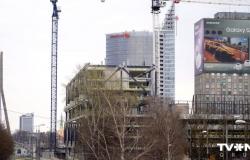In Latvia, it is quite unclear what the middle class is in general and how real it is for us, experts of the Faculty of Social Sciences of the University of Latvia admit. Research has been conducted on issues of social inequality, but mostly on the poorest part of society, including consulting the Latvian Ombudsman. Researching the changes of the middle class, which is the backbone of society, is hampered by a lack of funding.
These are the main conclusions after Dienas Biznesa’s conversation with associate professors Līga Rasnača and Baiba Bela of the Faculty of Social Sciences of the University of Latvia.
What is the middle layer? Are there changes?
“It is quite unclear what we generally mean by this concept – middle class or middle layer -. In 2018, an SKDS study was conducted, where a comparison was also made with the data of the study 10 years ago. One of the conclusions was that it is good – our middle class has grown! However, when analyzing individual factors, it turned out that nothing has changed significantly in 10 years,” said L. Rasnača. She emphasizes that people’s own feelings and self-perception in society are of great importance. “It is clear that more than half of the members of society want to define themselves as middle class. Then there is the question of how to measure this belonging to the middle class, and the first of all is income, because it is a clear and understandable quantity. At the same time, it must be said – this is by no means the only criterion,” says L. Rasnača, justifying it with aspects of social security and security in the country in general. First of all, when losing a job in Latvia, does a person remain middle class or not? What are the guarantees for a person’s financial position in times of crisis? On the other hand, there is a question – what are the requirements to belong to the middle class?
“For example, social ties, education, work experience, skills – what are they for a person to belong to the middle class of society? This is also where the aspect of common security is revealed. Namely, the story is about a group of people who are able to analyze, pay attention to political developments, are able to weed out populist statements. In short, the middle class ensures the stability of society also at the political level. Finally, the middle class is also a pillar of normal demography, because by definition it also means that it is a family with children that has an adequate home and the opportunity to give the children everything they need,” says L. Rasnača, emphasizing that there is a lot of pressure in developed countries to the middle class and its actual decline. It is not only a trend in Latvia that the part of the society that can identify itself as a representative of the middle class in a specific area is decreasing. This is due to global changes that are changing the very sources of material stability. Such an influence on the source of stability can also be local, unique to Latvia.
“Currently, the measurements of the middle class in Latvia, carried out by SKDS in 2018, were based on the criteria set by the people themselves, who are the middle class in Latvia. There is no such general standard as it is, because the wealth levels of countries differ in nature, and what belongs to the middle class in one country or territory can be rich in another country or, on the contrary, poor in yet another. Of course, the domestic research was based on income, real estate, education and other criteria, but the content of work was less taken into account, which, in my opinion, is an important factor,” admits L. Rasnača. According to her, it is important to note that people are willing to do what they like, sacrificing income. To put it simply, the middle class is not ready to go do some work just for good pay.
Explores the possibilities of the needy
“2018. in 2016, the research in which we focused on the study of the poorest part of the society ended,” says B. Bela, emphasizing that it was the last in this field until today. Dienas Bizness, however, eagerly listened to the results, because to a certain extent it can also be applied to the definition of the middle class, because if it is clear how many are poor, at least an idea of those who are not poor emerges. When asked why research on social inequality is not continued, B. Bela emphasized the lack of funds for science, which is the main obstacle to creating quality works.
“It’s labor-intensive, and we can’t do it with the League in the evenings as a hobby,” the scientist says with a smile. At the same time, it must be said – there are several conclusions about the general well-being of the population of Latvia, which B. Bela draws from the researches carried out until 2018, as well as following European quality of life measurements in general. “There is a certain income threshold up to which money has a big impact on life. However, if the basic needs are satisfied, then the further increase in income does not change the situation or satisfaction with the quality of life that much,” emphasizes B. Bela, mainly emphasizing what the measurements of the Central Statistics Office on indicators of material insecurity already show. “We have measurements of what people can eat, buy, afford. The data for 2022 surprised me a little, because 10% of the population cannot afford quality food. There were more than a third of such people in the poorest part of society or among the population below the poverty risk threshold,” emphasized B. Bela.
We just think we are middle class
From what the two scientists said, one unpleasant conclusion has to be drawn, whether one will or not, that one part of Latvian society likes to classify itself as a wealthy section or middle class, but in reality, it cannot afford many things that belong to it. “A middle-class indicator could certainly be – is it possible to replace worn-out furniture in the household when necessary, or is it possible to travel outside the home for a week?” so B. Bell. “These are the indicators that show that the number of the middle class did not change during the ten years from 2008 to 2018. That is, people try to classify themselves as middle class, but in reality they cannot afford things that qualify for such a classification. After the 2008 crisis, it was observed that its impact deeply affected the middle class of Latvia, however, it must be said that this population group recovered faster than the poor,” B. Bela concludes, referring to the research conducted by the University of Lithuania on the poor part of society.
Riga, the rest and families with one child
“What the country should pay special attention to is the difference in income between Riga and the rest of Latvia’s regions. The separation of Riga and the backwardness of Latgale have been a problem for decades, and there is no indication that anything could change. The quality of a person’s life depends very much on which region of Latvia he lives in, and this puts the people of Latvia in a very unequal situation. In essence, a person’s well-being directly depends on how many kilometers away from Riga he lives,” emphasizes B. Bela. What she said is confirmed by the previously published statistical materials of the project Paēdusi sibedria – stable state, as well as the observations of the Association of Local Governments of Latvia. In addition, backwardness is also contributed by gaps in the country’s infrastructure, the inability to get to major cities, due to which people choose to leave the rural regions and often leave the country. Moreover, concluding this thought, L. Rasnača adds that the issues of demography and wealth of the middle class are closely related. “The size of the middle class is directly related to positive demographics. In a sense, it is also a testament to the middle class and its possibilities. Currently, we have the most families with one child,” concludes L. Rasnača. The truth of these words is also indicated by the fact that schools are being demolished in regions of Latvia, but new ones are being built in Pierīga.
Our middle class lives in poverty in Europe
From all that has been said above, one might think that at least the middle class of Latvia lives in Riga and the representatives of the authorities can sleep peacefully, but this is not the case at all. “Researching European quality of life data and looking at Latvia as a sample from the European average, there is one indication. Even the wealthiest quintile of Latvian society has more material difficulties than the poorest quintile of Danish society. Namely, looking at the Latvian middle class, it can be said that it is quite thin! Already taking the data of the Central Statistics Office of Latvia on indicators of material insecurity by the income level of the population as a percentage, the first two quintiles are experiencing really serious difficulties, but it is not quite the case that there is no economic tension in the next two quintiles as well. In other words, this economic tension also exists in the conditionally wealthy strata of the population, and they cannot afford even several of the generally accepted material security things,” B. Bela emphasized to Dienas Biznesam.
In conclusion, it must be concluded that the sociologists of the University of Latvia, studying the needs of the socially disadvantaged strata of Latvia, have come to the unpleasant realization that even the middle class of Latvia cannot afford much. “Actually, those who receive above the national average salary in Latvia can safely be called this middle class, and here we are talking about the last or upper quintile according to CSB data,” says B. Bela, and it must be said that it is a depressingly smaller part of Latvian society.
A well-fed society – a stable country is a series of articles with the analysis of statistical data on the level of public wealth over the past 5 years, in order to demonstrate the current situation, the reasons for social inequality, as well as to present the main decisions or actions not taken, which is why we are in a certain critical situation.The project is financed by the Media Support Fund from the funds of the Latvian state budget. About A well-fed society – a stable country the content is the responsibility of SIA Izdevniecība Dienas Bizness.
#1/2
Baiba Bela, associate professor of the Faculty of Social Sciences of the University of Latvia.
Publicity photo

#2/2
Līga Rasnača, associate professor of the Faculty of Social Sciences of the University of Latvia.
Publicity photo
See the rest of the pictures
Tags: Latvia poor studied middle class conditional Dienas Bizness
-







